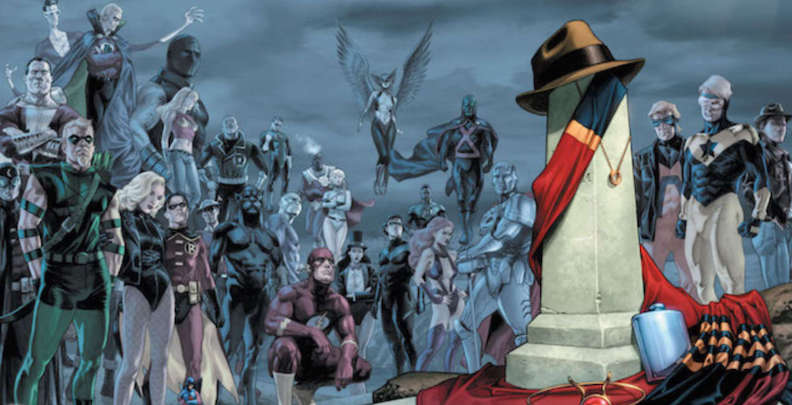Nobody thought it could be done, but a superteam of comic book creators banded together to tell a story once a week – every week – for a year without missing a beat. The legacy of 52 – which debuted 15 years ago today – brought the weekly comic back into the forefront for years to come.
As DC Comics was knee deep in the universe-altering Infinite Crisis in 2005-2006, the rest of the publisher’s line was jumping one year ahead, allowing creators to make some interesting – and unexplained – changes to its heroes and villains. In order to explain what happened to lead in to everything in the “One Year Later” jump, DC Comics introduced an almost-unheard-of idea: a major weekly series that would release every Wednesday for one year – 52 whole issues – that would clue readers in on life in the DC Universe in a world where Superman, Batman and Wonder Woman have decided to take a step back from their duties as heroes.
The aptly-titled 52 had maybe the greatest collection of writers of the time collaborating on the series. Keith Giffen laid out the story while Geoff Johns, Grant Morrison, Greg Rucka and Mark Waid took turns putting words in our heroes mouths, with the writers splitting up duties over several ongoing stories and more than a dozen artists chipping in to ensure that every issue came out on time. With the company’s big three heroes nowhere to be found, a lot of lesser characters got the chance to shine in 52. Each issue featured a few pages following several different DC Comics characters, each on their own personal quest.
Ralph Dibny sought for a way to bring his wife, Sue, back after she was murdered in the pages of IDENTITY CRISIS; Booster Gold investigates anomalies in the time stream and mysterious scribblings in Rip Hunter’s lab; Renee Montoya found her way to becoming the new Question, as she teamed up with Batwoman to take on Intergang and the Crime Bible; Animal Man, Starfire and ADAM STRANGE found themselves stranded in deep space and had to find their way back to Earth; Black Adam found a new path with a new family; Lex Luthor created a new program to give everyone superpowers, attracting the daughter of Steel, Natasha Irons; and several mad scientists were hidden away on an island to do mad scientist things in service of causing chaos around the world.
Sometimes the stories intersected, but mostly each of 52’s threads remained untangled throughout the year, told a few pages at a time. The series was a masterstroke of pacing and timing. There was so much going on with each issue – especially in the early weeks as the writers set up each story – but nothing was ever overwhelming and no one story took the main focus from the others until things began to get wrapped up at the end of the year.
Of note was Week 50, when World War III broke out in the DC Universe, as Black Adam went on a tear against the rest of the world after his new family was murdered by the Four Horsemen of the Apocalypse created by the mad scientists on Oolong Island. Not only was all of that issue taken up by Black Adam battling the rest of the world’s superheroes, but DC Comics also released a four-issue miniseries to tie in to Week 50 to expand on the war.
My favorite storyline within 52 probably belonged to Ralph Dibny, the heartbroken Elongated Man, whose search to bring his dead wife back to life brought him into the mystical corners of the DC Universe. Dibny encountered some strange stuff on his journey, including a cult that worshipped Superboy and sought to return him to life after he died during Infinite Crisis. The cult wanted to test out the process of Sue, and resulted in a straw effigy of her calling out to Ralph as it burned up. All of the suffering Dibny went through during his 52 story were the machinations of the wizard Felix Faust, who wanted to trade Dibny’s pure soul to the devil Neron in exchange for his freedom. But Ralph was too smart for Faust and Neron, as he died trapping the pair in the tower of Doctor Fate.
In the end, the title of the series wasn’t just a call out to the number of issues it would run but also the secret to which it was building for a whole year: the DC Comics multiverse had been restored. Instead of infinite Earths and universes, there were 52. The number has become an ongoing Easter egg within DC Comics and its versions in other media, with frequent references to 52 being seen in the ARROWVERSE over the years.
After 52 hit with a lot of critical success, DC Comics went back to the weekly well pretty frequently in the years that followed. Countdown to Final Crisis followed, along with Trinity, a series about Superman, Batman and Wonder Woman. None of the weekly series that followed had nearly as much impact or acclaim as 52, which set the standard for the format.
What were your favorite parts of 52? Let us know in the comments!
